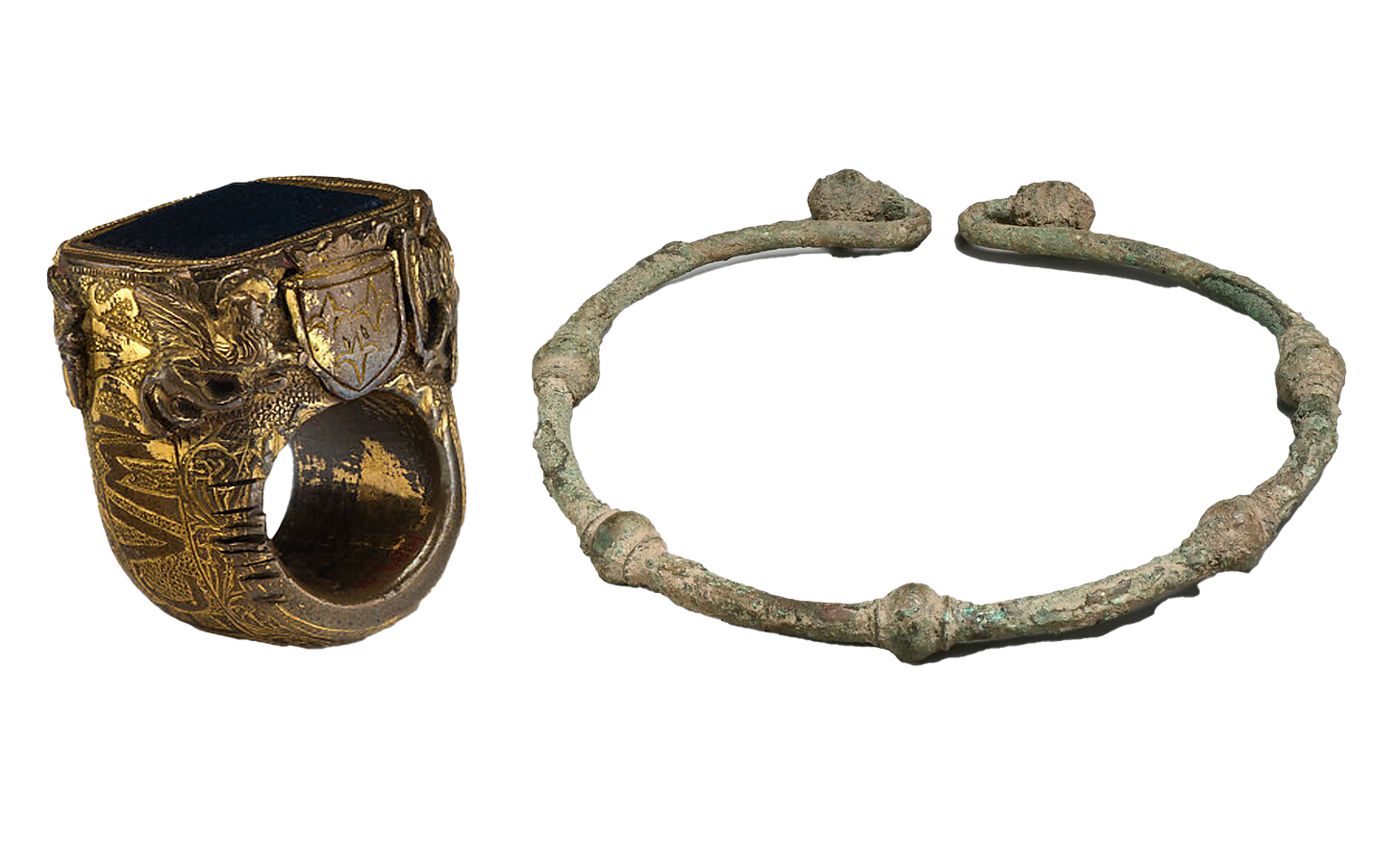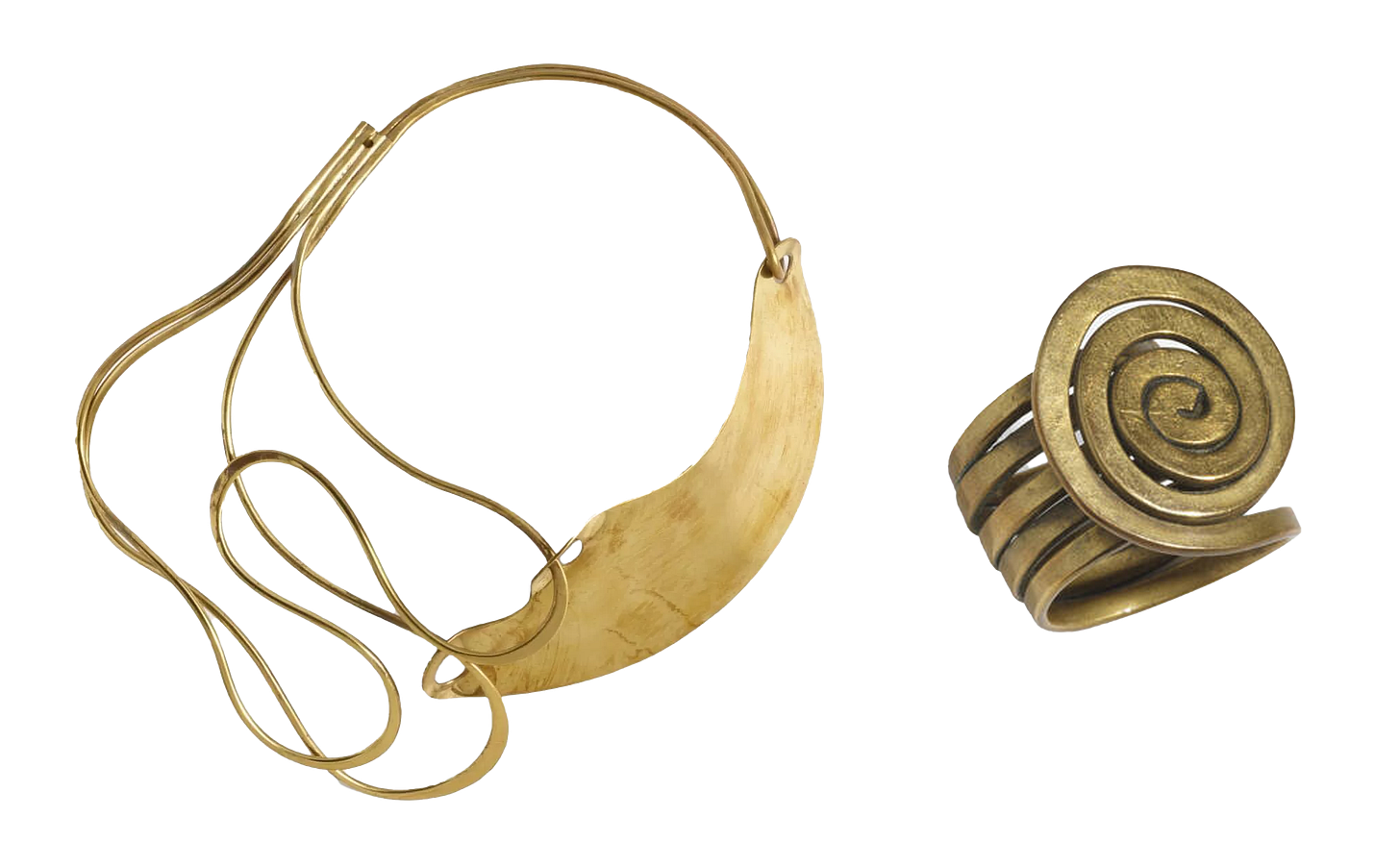I was scrolling through my home feed on Substack when I came across a post talking about the different metals used in jewelry. At the end of their first paragraph, they bluntly stated ‘brass = bad’ without doing any in-depth research. This made my blood boil. Most likely, because I use brass to make half of all my jewelry, but also because this person was simply misinformed.
There is a negative stigma around brass jewelry that, I believe, stems from the cheap jewelry that places like H&M and Zara make, which is typically copper, plated with a gold-toned coating. This misconception that these types of brands use brass has bothered me for a very long time, so I wanted to debunk the stigmas around the low worth and perception of brass jewelry.
Artists like Art Smith and Alexander Calder both relied on brass to sculpt their incredible works of wearable art, shown below. Since brass is an inexpensive and abundant material, they were able to utilize it for its gold-like properties, creating these larger-than-life pieces of jewelry that would have otherwise cost a fortune to make in any karat of gold.
Brass and bronze have been used to make jewelry for millennia, dating back to 3000 BCE in ancient Mesopotamia and Egypt. It tends to oxidize and break down over time (and by over time, we’re talking centuries), unlike gold, which endures, keeping its brilliant color and doesn’t rust or disintegrate. So while brass’s longevity is not equal to that of gold, no other metal on the planet is, including sterling silver.

Does brass tarnish? Yes. Does sterling silver tarnish? Yes. Can you polish both back up to look brand new? Yes. So while brass does tarnish, it shares very similar properties with sterling silver, and polishes up in exactly the same way using the same solutions and polishing cloths. It will always shine back to a gold-like color, unlike the plated copper jewelry from fast-fashion brands. So never throw away your solid brass jewelry, because with a little extra care, it can look like-new again.
I recommend storing your brass (and silver) jewelry in a place away from the sun (I keep mine in a velvet jewelry box in a drawer), and if you wear it often, the oils from your skin will help to keep your pieces from tarnishing.
A valid complaint that people do have about brass is that it can turn some people’s fingers black or green. It truly depends on one’s body chemistry, and while many don’t react to this metal, some do. Why does it do this? The copper content in the alloy of the brass can react with the pH of your skin and cause marks to appear. This is where I think people confuse the cheaply produced copper jewelry from places like Zara with brass, because both can turn your finger green/black.
These marks can also happen with solid gold jewelry, due to something called metallic abrasion, which can happen if you are using certain lotions, perfumes, oils, and creams. Any of these may contain compounds that can react with the metal in your jewelry. A big ingredient that causes these marks is zinc oxide, often found in sunscreens, makeup, and lotion.
While these marks aren’t ideal or attractive, they are completely harmless, and the issue can be solved by coating the ring shank with clear nail polish or having the ring gold-plated, but personally, I don’t like gold-plating my jewelry for two reasons:
Because it uses harsh chemicals like cyanide that are horrible for the environment, meaning those brands that claim sustainability but are using gold plating are straight up lying to you about their ‘sustainable’ practices.
It’s not a permanent solution. While it’s a cheaper alternative to solid gold, it lasts for only a short time, and then you will have to keep up with plating it over and over. At this point, I would recommend saving up to get either 10kt or 14kt gold, if you really do not want to purchase brass.
The last issue I have is when people talk about brass jewelry being worthless because brass itself is a cheap material. That would be like saying this paint and canvas wasn’t expensive, so why is this painter’s work worth thousands upon thousands of dollars? It all comes down to craft, perceived beauty, and the experience of the jeweler or artist. Alexander Calder’s famous neck/chest-piece, titled The Jealous Husband, as seen in this iconic image of Anjelica Huston, is considered a true work of art that holds prestige and value, yet is made out of brass.

I think people also tend to forget, or aren’t aware of the costs added and time spent during the fabrication process. There’s casting, assembly, soldering, finishing, and polishing, to name a few. I once heard someone complaining on social media that a handmade chain from a Luxury brand was charging $1k for a gold-plated brass necklace. To be honest, that’s not an unfair price for something that is comprised of multiple little pieces that need to be assembled piece-by-piece, especially for something like a chain.
I understand that brass jewelry isn’t for everyone, but I can’t stand it when people spread misinformation about a material that I love and work with on a daily basis. I feel like brass is a very misunderstood material, and I especially experience it first-hand when I’m talking to customers at markets. Many of them simply don’t know about the properties of brass, but I am always happy to explain and inform.
So, the next time someone says brass jewelry is worthless and ‘bad’, you can kindly send them here.
I hope this helps clear up some of the misconceptions or misinformation that you may have held around brass!
Lovingly,
A very passionate jeweler.




